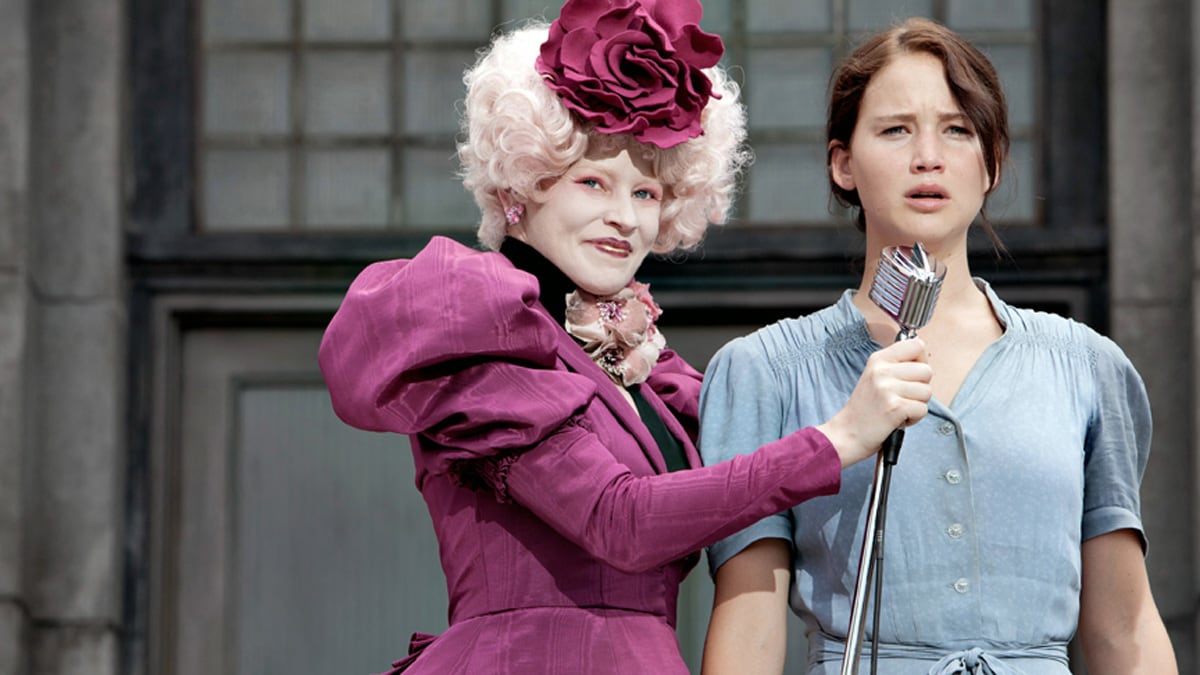Once unfairly labeled as “the new Twilight,” The Hunger Games has blossomed from young-adult fiction sensation to likely Hollywood blockbuster on its own terms. Literally. The absorbingly detailed world of Suzanne Collins’s dystopian sci-fi trilogy may not be as intimidatingly dense as the realms of J.R.R. Tolkien or George R.R. Martin, but it’s still packed with creative terminology and complex hierarchies.

For those unfamiliar with the basics, The Hunger Games takes place in a future version of North America where an oppressive government forces teens to fight to the death in an annual televised event. The story’s heroine is Katniss Everdeen (played in the film by Oscar-nominated Winter’s Bone star Jennifer Lawrence), a 16-year-old girl from a poverty-stricken coal-mining district who just happens to be an exceptional hunter. When her 12-year-old sister, Prim, is selected to compete in the Hunger Games, Katniss volunteers to go instead. The decision pits her against a casual acquaintance, Peeta Mallark (Josh Hutcherson), whose own feelings for Katniss aren’t so casual.
Part sci-fi adventure, part star-crossed romance, part biting commentary on a contemporary U.S. culture embroiled in war but obsessed with reality TV, The Hunger Games is smart and relatable enough to infatuate teens and sophisticated enough for adults to enjoy guilt-free.
But if you’re still too embarrassed to pick up a copy, or just need a quick refresher on what’s what in the world of tributes and game makers, here’s a guide to the novel’s—and now the film’s—key terms, from Panem to Mockingjay.
Panem: The country that emerged from “the ashes of a place once called North America.” It’s divided into 12 districts overseen by a totalitarian government. The age of Panem is unclear, but it has existed in its current state for about 75 years. What exactly happened to North America is also unclear, although a combination of disasters, droughts, storms, fires, and rising sea levels radically altered the landscape and spurred a brutal war for resources. The name Panem is derived from the Latin phrase “Panem et Circenses” (“Bread and Circuses”), used to describe a focus on superficial matters in politics and public life.
The Capitol: The center of power, wealth, and luxury in Panem. The Capitol sits in the Rocky Mountains, which serve as a natural barrier to and from its surrounding districts. It’s a candy-colored city filled with high-rise buildings and excessive materialism. Food appears at the touch of a button. Plastic surgery is common, as is dyeing one’s skin or hair bold, unusual colors. There is little to no communication between the Capitol and the districts, as the fortunate Capitol residents live a pampered and sheltered existence. The Capitol is ruled by President Snow (played by Donald Sutherland).
Districts: The 12 districts that make up the majority of Panem provide the Capitol with all of its material goods. Each district exists in relative isolation and is dedicated to a single industry, which in turn determines the citizens’ relative wealth and comfort level. As a general rule, the lower the district number the better off its citizens. Katniss lives in District 12–the poorest and most dangerous district, located in the Appalachian region and responsible for coal mining. Prior to the establishment of the Hunger Games, there were 13 districts, but when the districts rebelled against the Capitol, District 13 was destroyed.
Hunger Games: An annual event established 74 years ago as a punishment for the districts’ rebellion against the Capitol. Every year, each of the 12 districts selects two young people, one boy and one girl, in an event called “the reaping” (see below) to participate in a savage fight to the death broadcast nationally for the entertainment of all citizens. There can only be one victor. Even though the cost is 23 young lives lost every year, the Hunger Games are treated as a media spectacle and sporting event (especially in the Capitol, where no one is forced to participate, only observe and enjoy). Bets are placed on who will win, and the participants become celebrities as their alliances, relationships, and lethal face-offs are presented in the dramatic context of reality TV. As the mayor of District 12 says in the novel, the Games are “both a time for repentance and a time for thanks.”
Tributes: The participants in the Hunger Games, aged 12 to 18. Their names are typically drawn from a lottery, though it’s also possible to volunteer. Once 23 tributes have faced their deaths, the sole survivor returns home to live a life of comfort and celebrity. Their district receives prizes–mostly an abundance of resources like grain, oil, sugar–for the following year.
Reaping: The lottery used to determine the tributes. In every district, a citizen’s name is entered once at the age of 12, the first year of eligibility. Entries are cumulative (meaning if you weren’t picked in your first year that entry remains in the pool for the next year, when your name is also added again as a new entry for the new year) to stack the odds in favor of older tributes. Potential tributes are also permitted to enter their names one additional time in exchange for a year’s ration of grain and oil for themselves or each member of their family, even if it means risking possible death upon selection for the Games. This system means the poorer tributes are more likely to be picked since they need the rations. These extra entries also remain in the pool every year until a citizen turns 19.
Career Tributes: Also known as Careers, these are kids from wealthier districts—particularly Districts 1 and 2—who volunteer as tributes for the Hunger Games. It’s technically against the rules to train in advance for the Games, but the Capitol does nothing to stop the Careers, who spend most of their childhoods proudly preparing for a chance at celebrity and representing their district. The Careers are frequently victorious, leading to a vicious cycle of certain districts essentially supporting the merciless Games for their own self-interest.
Mentors: Every tribute is assigned a mentor, a previous Hunger Games winner who offers advice and serves as a “lifeline to the world” when competing in the Games. Katniss and Peeta are mentored by Haymitch Abernathy (Woody Harrelson), a malcontent middle-aged drunk and the only living champion in District 12.
Escorts: Capitol representatives who preside over the reaping and then travel with the tributes to the Capitol to prepare for the Hunger Games. District 12’s escort is Effie Trinket (Elizabeth Banks), a “maniacally upbeat” woman who happily chirps the Games’ cruel catchphrase “May the odds be ever in your favor!”
Stylists and Prep Teams: A small team of experts assigned to dress and style each individual tribute throughout the events leading up to the Hunger Games. Most stylists are celebrities in their own right, working with different tributes each year. But Katniss is assigned a novice stylist, Cinna (Lenny Kravitz), who helps her make a fiery first impression in her official debut as a tribute.
Sponsors: Wealthy citizens of the Capitol who offer financial support to tributes “either because they’re betting on them or simply for the bragging rights of picking a winner.” It’s the mentor’s job to arrange sponsor support for the tributes, and sponsors provide expensive gifts (food, medicine, etc.) that can be sent to the tributes at strategic times during the Games. It’s said the “best-looking tributes always seem to pull more sponsors” and “if you have no sponsors, the odds of staying alive decrease to almost zero.”
Arenas: The vast outdoor venues where the Hunger Games take place. The location changes every year and can be “anything from a burning desert to a frozen wasteland.” After the Games, the arenas are preserved as historic sites and become vacation destinations for Capitol citizens. Tourists can “rewatch the Games, tour the catacombs, visit the sites where the deaths took place. You can even take part in reenactments. They say the food is excellent.” During the Games, there are no rules in the arena, though cannibalism is frowned upon.
Gamemakers: They design the arenas and determine the obstacles unique to each Hunger Games. Before the Games, the Gamemakers spend time observing the tributes during training and assign each tribute a skill ranking of one to 12, to help establish odds for betting and create a rooting interest in certain tributes. The Gamemakers also track the location of each tribute during the Games with the use of a device implanted in the skin. This allows them to create events that will force tributes together if the action slows down. In the film, Wes Bentley plays Seneca Crane, the head gamemaker.
Cornucopia: In the novel, Katniss describes the Cornucopia as “a giant golden horn shaped like a cone with a curved tail, the mouth of which is at least twenty feet high, spilling over with the things that will give us life.” It is revealed to the tributes when they first enter the arena and contains food, water, weapons, medicine, garments, fire starters, etc. Attempts to obtain these supplies place tributes in their first direct battles with each other, usually resulting in a bloodbath wherein career tributes slaughter easy prey and split up the spoils among their alliance.
Muttations: Genetically altered animals bred by the Capitol as weapons during the rebellion. Sometimes called “mutts” for short. One muttation, Tracker Jackers, are wasps with attacks that usually prove fatal after only a few stings and the ferocious instinct to hunt down anyone who disturbs their nest. Even a single sting can lead to hallucinations and madness. The Capitol used Tracker Jacker nests like land mines throughout the districts.
Mockingjay: A bird species resulting from a Capitol-bred muttation called Jabberjays mating with mockingbirds. Mockingjays cannot recite words but can mimic a full range of human sounds and faithfully recreate the melodies of songs. Because their existence was unforeseen and uncontrolled by the Capitol, Mockingjays are considered a symbol of rebellion. Katniss brings a Mockingjay pin as her personal item to the Hunger Games.






